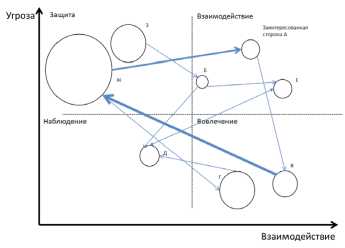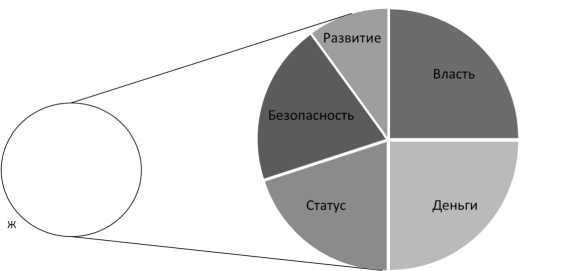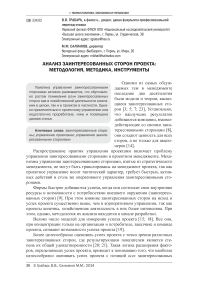Анализ заинтересованных сторон проекта: методология, методика, инструменты
Автор: Грабарь В.В., Салмаков М.М.
Журнал: Ars Administrandi. Искусство управления @ars-administrandi
Рубрика: Теории политики, экономики и управления
Статья в выпуске: 2, 2014 года.
Бесплатный доступ
Тематика управления заинтересованными сторонами активно развивается, что обусловлено ростом понимания роли заинтересованных сторон как в хозяйственной деятельности компании в целом, так и в проектах в частности. Однако применительно к проектному управлению она недостаточно проработана, чему и посвящена данная статья.
Заинтересованные стороны, управление проектами, управление заинтересованными сторонами
Короткий адрес: https://sciup.org/147204120
IDR: 147204120 | УДК: 334.02
Текст научной статьи Анализ заинтересованных сторон проекта: методология, методика, инструменты
Одними из самых обсуждаемых тем в менеджменте последние два десятилетия были модели и теории, касающиеся заинтересованных сторон [3; 5; 7; 23], Установлено, что наилучших результатов добиваются компании, взаимодействующие со своими заинтересованными сторонами [8], они создают ценность для всех сторон, а не только для акционеров [14].
Распространение практик управления проектами включает проблему управления заинтересованными сторонами в проектном менеджменте. Механизмы управления заинтересованными сторонами, взятые из стратегического менеджмента, не могут быть транслированы на менеджмент проекта, так как проектное управление носит тактический характер, требует быстрых, активных действий и столь же оперативного управления заинтересованными сторонами.
Фирмы быстрее добиваются успеха, когда они соотносят свои внутренние ресурсы и возможности с потребностями внешнего окружения (заинтересованных сторон) [9]. При этом влияние заинтересованных сторон на исход и успех проекта существенно выше, чем в корпоративном управлении, так как проекты конечны, хозяйственная деятельность в них более интенсивна. При этом, однако, методология их анализа находится в начале разработки.
Велико число моделей для измерения успеха проекта [15; 18]. Все они, при концентрации только на организации и потребителе, заказчике и команде проекта, снижают возможности успеха проекта [19].
Более целесообразно оценивать успех проекта с точки зрения различных заинтересованных сторон, где результирующим показателем является степень их общей удовлетворенности [20; 21]. Такая логика расширения факторов, определяющих успех проекта, приводит к пониманию того, что наиболее целесообразно оценивать успех проекта с позиций всех заинтересованных
Грабарь В.В., Салмаков М.М. Анализ заинтересованных сторон проекта: методология, методика, инструменты сторон, анализировать их, балансировать интересами заинтересованных сторон, управлять ими.
Заинтересованная сторона – любая группа или индивид, способная влиять или влияющая на достижение цели организации [4], на способность предприятия приносить доход, а также все бенефициары и источники риска [14]. Под заинтересованными сторонами понимаются как субъекты хозяйственной деятельности, состоящие в прямых экономических отношениях с организацией [2], так и все общество в целом и каждый его член в отдельности [17].
Существует большое количество подходов к классификации заинтересованных сторон [1; 6; 12; 13; 22]: первичные и вторичные; прямые и косвенные; общие и специализированные; стратегические и этические; нормативные, косвенные и опасные (спящие) заинтересованные стороны.
А. Менделоу [10] анализирует заинтересованные стороны в зависимости от их интересов и их власти, соответственно способности влиять на деятельность предприятия и желанием делать это. Интегрированный показатель – влияние заинтересованной стороны, определяется путем перемножения власти и интереса.
Расширением модели А. Менделоу можно назвать типологию Р. Митчелла [11] (рис. 1). В основе типологии – три фактора: законность, значимость и срочность, т.е. юридическая легитимность отдавать указания, сила влияния заинтересованной стороны на предприятие, минимально необходимая скорость ответов на запросы заинтересованной стороны.
Стороны, которым присуща только одна характеристика, являются скрытыми, бездействующими. Заинтересованные стороны, которым присущи две характеристики, являются выжидающими. Набольшим влиянием обладают заинтересованные стороны, влияние которых узаконено, значимо, и которые решают вопрос в кратчайшие сроки (категорическая группа).
Становится ясно, какой же из заинтересованных сторон необходимо уделить большее внимание, а какой меньше.

Рис. 1. Модель Р. Митчелла
|
Угроза' |
‘ Защита |
Взаимодействие |
|
Наблюдение |
Вовлечение |
Взаимодействие
Рис. 2. Модель Г. Саважа
В свою очередь, Г. Саваж [16] не только классифицирует заинтересованные стороны, но и предлагает наиболее уместные стратегии взаимодействия с ними, что отражено на рис. 2.
Его типология и стратегии основаны на определении потенциала (вероятности) заинтересованной стороны нанести ущерб организации и ее потенциала (готовности) к сотрудничеству.
При высоких вероятностях взаимодействия и угрозы рекомендуется придерживаться стратегии взаимодействия (переговоров). При высокой угрозе и низком взаимодействии – придерживаться стратегии защитника. Когда у заинтересованной стороны наблюдается высокий уровень взаимодействия при низкой угрозе, рекомендуется использовать стратегию вовлечения.
С заинтересованными сторонами с низким уровнем угрозы и с низким уровнем кооперации – придерживаться стратегии наблюдения с целью отслеживания изменения их статуса. Менеджерам следует большое внимание уделять тем стейкхолдерам, которые обладают высоким потенциалом к кооперации, так как взаимодействие с ними может принести большую пользу в будущем и активно содействовать перемещению заинтересованных сторон из менее привлекательного сегмента в более привлекательный.
А. Фридман и С. Майлс [5] включают в список заинтересованных сторон потребителей, сотрудников, местное сообщество, поставщиков и дистрибьюторов, акционеров, СМИ, общество в целом, бизнес-партнеров, будущие и прошлые поколения, представителей научного сообщества, конкурентов, гражданское общество, представителей заинтересованных сторон со своими интересами, инвесторов, органы государственной власти.
В контексте проектного управления перечень и характеристики заинтересованных сторон – ключевых участников проекта можно найти в Своде знаний об управлении проектами PMBoK: менеджер проекта; заказчик/пользователь;
исполняющая организация; члены команды проекта; команда управления проектом; спонсор; офис управления проектом (PMO).
Совместим два перечня заинтересованных сторон проекта, разделив их на внутренние и внешние, и выявим их ключевые интересы.
На проект влияют:
-
- его внутренние заинтересованные стороны, которые непосредственно участвуют в реализации проекта (менеджер проекта, команда управления проектом, члены команды проекта, офис управления проектами при его наличии, инвесторы проекта, поставщики проекта);
-
- внешнее окружение проекта, внутренняя среда компании, в рамках которой реализуется проект (кредиторы компании, акционеры компании, менеджмент компании, бизнес-партнеры компании, сотрудники компании, будущие поколения, прошлые поколения, представители заинтересованных сторон, внутрикорпоративные потребители);
-
- внешнее окружение компании, все бизнес окружение, в котором функционирует организация (внешние потребители, местное сообщество, СМИ, общество в целом, научное сообщество, конкуренты, гражданское общество, органы государственной власти).
Для каждой группы лиц, относящихся к заинтересованным странам проекта, можно определить их основные интересы (таблица).
Таблица
Основные заинтересованные стороны проекта и их интересы
|
Наименование стейкхолдера |
Основные интересы стейкхолдера |
|
1 |
2 |
|
Внутренние заинтересованные стороны проекта |
|
|
Менеджер проекта |
Выполнение проекта Достижение целевых показателей проекта Карьерный рост |
|
Команда управления проектом |
Достижение целевых показателей проекта Карьерный рост |
|
Члены команды проекта |
Будущая защищенность их рабочих мест Рост заработной платы Карьерный рост |
|
Офис управления проектами |
Сохранение баланса портфеля проектов Достижение целевых KPI |
|
Инвесторы проекта |
Получение запланированной доходности проекта |
|
Поставщики проекта |
Выполнение взятых на себя обязательств Четкая постановка технического задания |
|
Внутрикорпоративные заинтересованные стороны проекта |
|
|
Кредиторы компании |
Своевременная выплата обязательств Сохранение текущего уровня риска, выраженного в целевых показателях |
|
Акционеры компании |
Рост доходности компании Рост дивидендных выплат Рост стоимости компании |
|
Менеджмент компании |
Достижение компанией целевых показателей KPI Рост размера компенсации Сохранение текущего положения Развитие компании |
|
Бизнес партнеры компании |
Сохранение долгосрочных отношений с компанией |
|
Прочие сотрудники компании |
Рост заработной платы Сохранение рабочих мест Карьерный рост |
|
Будущие поколения |
Создание потенциала для развития компании в будущем |
Окончание таблицы
|
1 |
2 |
|
Прошлые поколения |
Сохранение преемственности стратегии |
|
Представители заинтересованных сторон |
Улучшение положения подопечных заинтересованных сторон |
|
Внутрикорпоративные потребители |
Выполнение поставленного технического задания точно в срок Упрощение ведения деятельности |
|
Внешние заинтересованные стороны проекта |
|
|
Внешние потребители |
Удовлетворение потребностей |
|
Местное сообщество |
Сохранение окружающей среды Модернизация окружающего пространства |
|
СМИ |
Создание информационных поводов |
|
Общество в целом |
Улучшение текущего положения |
|
Научное сообщество |
Получение материалов для проведения исследований |
|
Конкуренты |
Рост их доли на рынке Рост их капитализации |
|
Гражданское общество |
Защита интересов граждан Развитие института гражданского общества |
|
Органы государственной власти |
Выполнение требований органов государственной власти Увеличение размера отчислений в бюджет Поддержка реализуемой стратегии развития |
Тем не менее методики и инструменты анализа заинтересованных сторон проекта, при всей существующей в этом потребности, нуждаются в разработке.
Подход авторов к анализу заинтересованных сторон состоит из трех уровней такого анализа. Первый уровень отвечает за общий анализ групп заинтересованных сторон и является симбиозом подходов Г. Саважа и Р. Митчелла (рис. 3).
Размер окружностей, обозначенных на рис. 3, – интегрированная степень влияния конкретной заинтересованной стороны, которая, в свою очередь, зависит от законности, срочности и значимости ее требований.

Рис. 3. Авторский подход к анализу заинтересованных сторон

Рис. 4. Анализ заинтересованных сторон. Уровень 2

Рис. 5. Анализ заинтересованных сторон проекта. Уровень 3
Второй уровень анализа представляет собой детализацию заинтересованных сторон и их связей в каждом сегменте: защита, вовлечение, наблюдение, взаимодействие (рис. 4).
Третий уровень анализа представляет собой индивидуальный поведенческий и мотивационный профиль конкретной стороны, позволяющий максимально эффективно оценить и управлять взаимоотношениями с ней (рис. 5). За основу индивидуального управленческого профиля приняты интересы основных заинтересованных сторон, представленные выше.
Алгоритм анализа таков: менеджер выявляет все ключевых группы заинтересованных сторон, проводит экспертную оценку степени угрозы, исходящей от них, их готовности к взаимодействию, законности, срочности и значимости их требований, результаты анализа вносит в вышеобозначенную модель и строит график.
Далее проводит выявление основных ключевых лиц (движущих сил) в каждом сегменте, группе заинтересованных сторон, а также их интересов. На основе полученных результатов строится локальная карта заинтересованных лиц, отражающая их интересы и взаимосвязи, а затем для целевых заинтересованных лиц строятся индивидуальные поведенческие профили.
Определить вес (значимость) заинтересованной стороны на карте возможно по средневзвешенным экспертным оценкам власти, законности и срочности (Р. Митчелл) по следующей формуле (1):
Вес (значимость) заинтересованной стороны = k × власть + n × законность + m × срочность,
где k, n, m – весы критериев.
Значимость каждого критерия (власть, срочность, законность) определяется распределением между ними 100 баллов. По оценке экспертов были получены следующие результаты:
-
- коэффициент k (вес критерия Власть) составляет 40%;
-
- коэффициент n (вес критерия Законность) составляет 40%;
-
- коэффициент m (вес критерия Срочность) составляет 20%.
Таким образом, конечный вид формулы веса (значимости) заинтересованной стороны (2) принимает следующий вид:
Вес (значимость) заинтересованной стороны = 0,4 × власть + 0,4 × законность + 0,2 × срочность.
Далее эксперты команды проекта оценивают каждый из критериев (власть, законность и срочность) по трехбалльной шкале, в которой 0 баллов – минимальный уровень (или полное отсутствие критерия), 1 балл – средний уровень, 2 балла – максимальный уровень присутствия критерия у заинтересованной стороны.
Таким образом, значимость каждой заинтересованной стороны может варьироваться от 0,2 балла до 2 баллов.
Определим границы состояний заинтересованных сторон:
-
- бездействующее состояние - от 0,2 балла до 0,7 балла (нижние 30%);
-
- выжидающее состояние - от 0,71 балла до 1,5 балла;
-
- категорическое (безусловное) состояние - от 1,51 балла до 2 баллов (верхние 30%).
Местоположение заинтересованной стороны на матрице относительно пары «угроза – взаимодействие» выявляется также экспертами. Каждый эксперт оценивает угрозу от заинтересованной стороны и степень ее готовности к взаимодействию на основе семибалльной шкалы. 7 баллов соответствуют максимальной степени угрозы и максимальной степени готовности к взаимодействию, а 1 балл – минимальной степени угрозы и минимальной готовности к взаимодействию.
Схема распределения баллов по осям представлена на рис. 6.
В соответствии с представленной схемой:
-
- от 1 до 3 баллов - низкая степень угрозы со стороны заинтересованной стороны и низкая готовность к взаимодействию;
-
- 4 балла - промежуточный результат. При большом количестве заинтересованных сторон, находящихся в данном промежутке по любой из осей, необходимо проведение дополнительных оценок;
-
- от 5 до 7 баллов - высокая степень угрозы со стороны заинтересованной стороны и ее высокая готовность к взаимодействию.
К заинтересованным сторонам, находящимся в определенном сегменте, необходимо применять соответствующие стратегии взаимодействия, которые описаны выше.
Угроза
|
• Защита |
Взаимодействие |
|
Наблюдение |
Вовлечение |
Рис. 6. Распределение баллов по осям
5 6 7
Взаимодействие
Крупные проекты с большим количеством заинтересованных сторон предпочтительнее для применения модели. Однако это не означает, что ее использование не может принести результатов в малых и средних проектах. Так, в ходе работы над статьей было проведено предварительное тестирование данного подхода на малых проектах, давшее положительные результаты.
Предложенный подход позволяет провести эффективный анализ заинтересованных сторон проекта, наглядно отразив их интересы и предлагая стратегии взаимодействия с ними.
Вопросы персонализации процесса управления заинтересованными сторонами, разработки их индивидуальных мотивационных профилей, уточнения взаимосвязей между заинтересованными сторонами требуют дальнейшей проработки.
Список литературы Анализ заинтересованных сторон проекта: методология, методика, инструменты
- Carroll A.B. Business and Society: Ethics and Stakeholders. Cincinnati: South-Western, 1989
- Cochran P. The Toronto Conference: Reflection on Stakeholder Theory//Business & Society. 1994. Vol. 33, № 1. P. 95-98
- Donaldson T., Preston L. The Stakeholder Theory of the Corporation: Concepts, Evidence, and Implications//Academy of Management Review. 1995. Vol. 20, № 1. P. 65-91
- Freeman R.E., McVea J. A Stakeholder Approach to Strategic Management//Blackwell Handbook of Strategic Management. Oxford: Blackwell, 2001
- Friedman A., Miles S. Stakeholders: Theory and Practice. Oxford: Oxford University Press, 2006
- Frooman J. Stakeholder Influence Strategies//Academy of Management Review. 1999. Vol. 24, № 102. P. 191-205
- Gibson K. The Moral Basis of Stakeholder Theory//Journal of Business Ethics. 2000. Vol. 26, № 3. P. 245-257
- Hardly C., Phillips N. Strategies of Engagement: Lessons from the Critical Examination of Collaboration and Conflict in an Interorganosational Domain//Organizational Science. 1998. Vol. 9. P. 217-230
- Henderson R., Mitchell W. The Interactions of Organizational and Competitive Influences on Strategy and Performance//Strategic Management Journal. 1997. Vol. 18. P. 5-14
- Mendelow A. ‘Stakeholder Mapping’, Proceedings of the 2nd International Conference on Information Systems. Cambridge, MA, 1991
- Mitchell R.K., Agle B.R., Wood D.J. Toward a Theory of Stakeholder Identification and Salience: Defining the Principle of Who and What Really Counts.//Academy of Management Review. 1997. Vol. 22, № 4. P. 853-888
- Pesqueux Y., Damak-Ayadi S. Stakeholder Theory in Perspective//Corporate Governance. 2005. Vol. 5, № 2. P. 5-21
- Phillips R. Stakeholder Theory and Organization Ethics. San Francisco: Berrett-Koehler, 2003
- Post J.E., Preston L.E., Sachs S. Redefining the Corporation: Stakeholder Management and Organizational Wealth//Stanford: CA, Stanford University Press, 2002
- Rad P.F. Project Success Attributes//Cost Engineering. 2003. Vol. 45, № 4. P. 23-29
- Savage G.T., Nix T.W. Whitehead and Blair. Strategies for Assessing and Managing Organizational Stakeholders//Academy of Management Executive. 1991. Vol. 5, № 2. P. 61-75
- Shackman N.A. Reframing the Debate between Agency and Stakeholder Theories of the Firm//Journal of Business Ethics. 1999. Vol. 19, № 4. P. 319-334
- Shanbar A., Levy O., Dvir D. Mapping the Dimension of Project Success//Project Management journal. 1997. Vol. 28, № 2. P. 5-13
- Stuckenbruck L.C. Who Determines Project Success?//Proceedings of 18th Annual Seminal/Symposium (Montreal, Canada). Upper Darby, PA: Project Management Institute, 1986. P. 85-93
- Tuman J. Models for Achieving Project Success Through Team Building and Stakeholder Management//The AMA Handbook of Project Management/ed. by P.C. Dinsmore. N.Y.: AMACOM, 1993
- Wideman M.R. How to Motivate All Stakeholders to Work Together//Field Guide to Project Management/ed. by D.I. Cleland. USA: International Thompson Publishing Company, 1998
- Winn M. Building Stakeholder Theory with a Decision Modelling Methodology//Business & Society. 2001. Vol. 40, № 2. P. 133-166
- Wolfe A., Putler D.S. How Tight Are the Ties that Bind Stakeholder Groups?//Organizational Science. 2002. Vol. 13, № 1. P. 64-82


